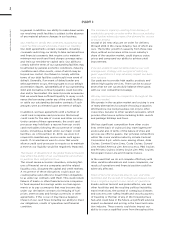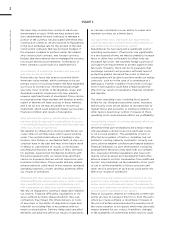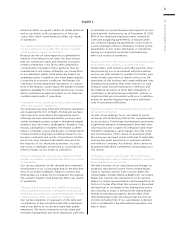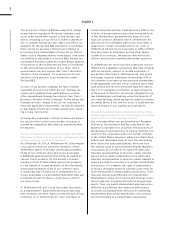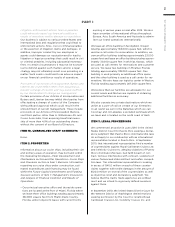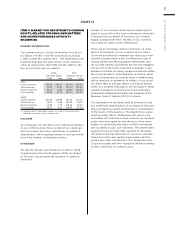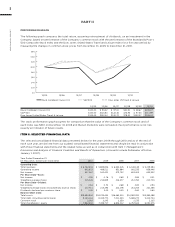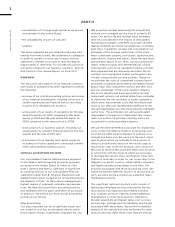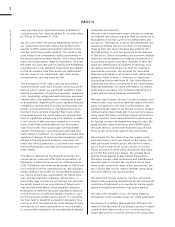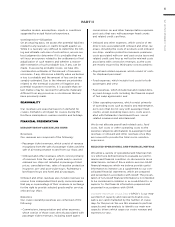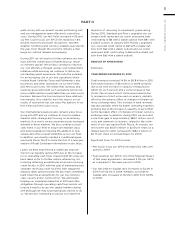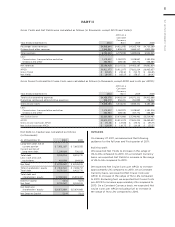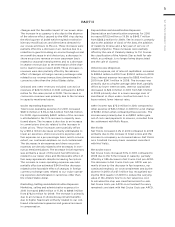Royal Caribbean Cruise Lines 2010 Annual Report Download - page 41
Download and view the complete annual report
Please find page 41 of the 2010 Royal Caribbean Cruise Lines annual report below. You can navigate through the pages in the report by either clicking on the pages listed below, or by using the keyword search tool below to find specific information within the annual report.
2010 ANNUAL REPORT 38
PART II
• uncertainties of a foreign legal system as we are not
incorporated in the United States;
• the unavailability of ports of call; and
• weather.
The above examples are not exhaustive and new risks
emerge from time to time. We undertake no obligation
to publicly update or revise any forward-looking
statements, whether as a result of new information,
future events or otherwise. For a further discussion of
risk factors related to our business, see Part I, Item 1A.
Risk Factors in this Annual Report on Form 10-K.
OVERVIEW
The discussion and analysis of our financial condition
and results of operations has been organized to present
the following:
• a review of our critical accounting policies and review
of our financial presentation, including discussion of
certain operational and financial metrics we utilize
to assist us in managing our business;
• a discussion of our results of operations for the year
ended December 31, 2010 compared to the same
period in 2009 and the year ended December 31,
2009 compared to the same period in 2008;
• a discussion of our business outlook, including our
expectations for selected financial items for the first
quarter and full year of 2011; and
• a discussion of our liquidity and capital resources,
including our future capital and contractual commit-
ments and potential funding sources.
CRITICAL ACCOUNTING POLICIES
Our consolidated financial statements are prepared
in accordance with accounting principles generally
accepted in the United States of America. (See
Note 1. General and Note 2. Summary of Significant
Accounting Policies to our consolidated financial
statements under Item 8. Financial Statements and
Supplementary Data.) Certain of our accounting policies
are deemed “critical,” as they require management’s
highest degree of judgment, estimates and assump-
tions. We have discussed these accounting policies
and estimates with the audit committee of our board
of directors. We believe our most critical accounting
policies are as follows:
Ship Accounting
Our ships represent our most significant assets and
are stated at cost less accumulated depreciation.
Deprecia tion of ships is generally computed net of a
15% projected residual value using the straight-line
method over estimated service lives of primarily 30
years. Our service life and residual value estimates
take into consideration the impact of anticipated
technological changes, long-term cruise and vacation
market conditions and historical useful lives of similarly-
built ships. In addition, we take into consideration our
estimates of the average useful lives of the ships’
major component systems, such as hull, superstructure,
main electric, engines and cabins. Given the very large
and complex nature of our ships, our accounting esti-
mates related to ships and determinations of ship
improvement costs to be capitalized require consider-
able judgment and are inherently uncertain. We do
not have cost segregation studies performed to spe-
cifically componentize our ship systems. Therefore,
we estimate the costs of component systems based
principally on general and technical information known
about major ship component systems and their lives
and our knowledge of the cruise vacation industry.
We do not identify and track depreciation by ship
component systems, but instead utilize these estimates
to determine the net cost basis of assets replaced or
refurbished. Improvement costs that we believe add
value to our ships are capitalized as additions to the
ship and depreciated over the improvements’ estimated
useful lives. The estimated cost and accumulated
depreciation of replaced or refurbished ship compo-
nents are written off and any resulting losses are
recognized in cruise operating expenses.
We use the deferral method to account for drydocking
costs. Under the deferral method, drydocking costs
incurred are deferred and charged to expense on a
straight-line basis over the period to the next sched-
uled drydock which we estimate to be a period of
thirty to sixty months based on the vessel’s age as
required by class. Deferred drydock costs consist of
the costs to drydock the vessel and other costs incurred
in connection with the drydock which are necessary
to maintain the vessel’s Class certification. Class certi-
fication is necessary in order for our cruise ships to be
flagged in a specific country, obtain liability insurance
and legally operate as passenger cruise ships. The
activities associated with those drydocking costs can-
not be performed while the vessel is in service and, as
such, are done during a drydock as a planned major
maintenance activity.
The significant deferred drydock costs consist of
hauling and wharfage services provided by the dry-
dock facility, hull inspection and related activities
(e.g. scraping, pressure cleaning, bottom painting),
maintenance to steering propulsion, stabilizers,
thruster equipment and ballast tanks, port services
such as tugs, pilotage and line handling, and freight
associated with these items. We perform a detailed
analysis of the various activities performed for each
drydock and only defer those costs that are directly


